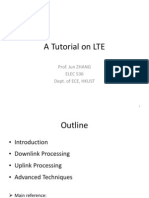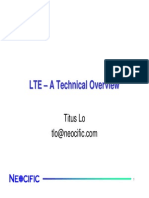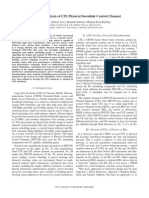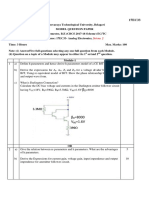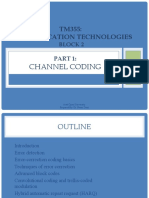Uplink-Transport Channel Processing Overview
Uploaded by
LikithaReddy YenumulaUplink-Transport Channel Processing Overview
Uploaded by
LikithaReddy YenumulaUplink Transport Channel Processing
Module-4
Uplink Channel Transport Processing
Uplink-Transport Channel Processing Overview
• The Transport Channel Processing in the Uplink is very similar to that of the
Downlink.
• It is divided into two distinct steps 1) Channel Coding 2) Modulation
• Since Spatial Multiplexing is not supported in the Uplink, data streams from the MAC
layer are presented to the encoding unit only one Transport Block for every subframe.
• The codeword after encoding is passed to the symbol mapping unit where the bits are
mapped onto complex valued symbols.
• Subsequently, the modulated symbols are processed to generate SC-FDMA signals
and mapped onto the assigned resource blocks.
• The general framework of Channel Processing, which is common to all Uplink
Transport Channels/Control Information.
Overview of Uplink Transport Channel Processing
Channel Coding Processing
• It includes CRC Addition, Code Block Segmentation, Channel Coding, Rate
Matching and Code Block Concatenation.
• The same Turbo encoder used for Downlink Shared Channels is also used for Uplink
Shared Channels.
• For Control Information, the Channel Coding scheme depends on the type of Control
Information and also on the type of the Physical Channel that carries the Control
Information.
• The Control Information in the Uplink can be mapped either to the Physical Uplink
Shared Channel (PUSCH) or the Physical Uplink Control Channel (PUCCH).
Padmaja Kumar, Dept. of ECE, GAT Page 1
Uplink Transport Channel Processing
Usage of Channel Coding Scheme and Coding Rate for Uplink Transport Channels
Usage of Channel Coding Scheme and Coding Rate for Uplink Control Information
Modulation Processing
• For the Modulation in the Uplink, the various steps such as Scrambling and
Modulation mapping are done in the same way as in the Downlink.
• Unlike Downlink, in Uplink specific Scrambling is applied in order to randomize the
interference.
• Also, since Spatial Multiplexing is not supported in the Uplink there is no layer
mapping or MIMO precoding.
• The main difference from the Downlink comes from the nature-of the SC-FDMA-
based transmission, which is different from the OFDMA- based transmission that is
used in the Downlink.
Generation of SC-FDMA baseband signals
Padmaja Kumar, Dept. of ECE, GAT Page 2
Uplink Transport Channel Processing
Generation of the SC-FDMA baseband signal
• The DFT-based precoding is applied to the block of complex-valued modulation
symbols, which transforms the time-domain signal into the frequency domain.
• In LTE, the DFT size is constrained to be products of the integers two, three, and five,
which is a tradeoff between the complexity of the implementation and the flexibility
on the assigned bandwidth.
• The DFT size also depends on the number of Resource Blocks assigned to the UE.
• The output of the DFT-based precoder is mapped to the Resource Blocks that have
been allocated for the transmission of the Transport Block.
• In LTE, only localized resource allocation is supported in the Uplink, that is,
contiguous Resource Blocks are assigned to each UE.
• The baseband signal sl (t) in SC-FDMA symbol l in an Uplink slot is defined by
for 0 ≤ t ≤ NC P,l + N) X Ts
where,
N is the size of FFT
∆f = 15KHZ
a k, l is the content of Resource Element.
Channel Mapping
• In the Uplink, UL-SCH is the only Transport Channel that carries traffic data.
• It can also be used to transfer control signals for higher layers.
Channel Mapping around the Uplink Shared Channel
Padmaja Kumar, Dept. of ECE, GAT Page 3
Uplink Transport Channel Processing
Channel Encoding and Modulation
• The Channel Coding scheme for data streams on the UL-SCH is the same as that for
the DL-SCH.
• A rate 1/3 Turbo encoder is used to encode the Transport Block. Effective code rates
other than 1/3 are achieved by either puncturing or repetition of the encoded bits,
depending on the Transport Block size, the modulation scheme, and the assigned
radio resource.
• The encoded symbols are scrambled prior to modulation, which is done to randomize
the interference.
• Instead of using a cell-specific scrambling as in the Downlink, a UE-specific
scrambling is applied in the Uplink.
• The UL-SCH is mapped to the PUSCH, which supports QPSK, 16QAM, and 64QAM
modulation schemes.
• The QPSK and 16QAM modulation schemes are mandatory and support for the
64QAM modulation is optional and depends on the UE capability.
• The modulation order and the redundancy version for the channel coding of the H-
ARQ protocol are contained in the 5-bit “modulation and coding scheme and
redundancy version” field (IMCS) in the Downlink Control Information (DCI) carried
on the PDCCH with format 0.
Frequency Hopping
• The resource mapper maps the complex-valued modulation symbols in sequence on to
the Physical Resource Blocks assigned for transmission of PUSCH.
• LTE supports Frequency Hopping on PUSCH, which provides additional frequency
diversity gain in the Uplink.
• In LTE both intra-subframe and inter-subframe Frequency Hopping are supported.
• In Intra – sub frame frequency hopping, UE hops to another frequency allocation from
one slot to another within the same subframe.
• Intra – sub frame Frequency Hopping provides higher frequency diversity gain since
this gain can be extracted over a single H-ARQ transmission.
• In Inter – sub frame Frequency Hopping, the frequency resource allocation changes
from one subframe to another.
Padmaja Kumar, Dept. of ECE, GAT Page 4
Uplink Transport Channel Processing
• Multiple H- ARQ transmissions are needed in order to extract the frequency diversity
gain in Inter – subframe Frequency Hopping.
• Depending on the value of the single bit Frequency Hopping (FH) field in the PDCCH
with DCI format 0, the UE shall perform PUSCH Frequency Hopping or not.
No Frequency Hopping
• If Uplink Frequency Hopping is disabled (FH = 0).
• Set of Physical Resource Blocks (PRBs) to be used for transmission is given by
nPRB = nVRB, where nVRB is the Virtual Resource Block index obtained from the Uplink
scheduling grant.
Frequency Hopping
• If Uplink Frequency Hopping is enabled (FH = 1).
• There are two Frequency Hopping types:
i. Type 1 Hopping: uses an explicit offset in the second slot, determined by
parameters in DCI format 0.
ii. Type 2 Hopping: the set of Physical Resource Blocks to be used for
transmission is given by the scheduling grant together with a predefined
Hopping pattern.
Illustrations of Frequency Hopping on PUSCH
Multiantenna Transmission
• Considering cost and complexity of the UE, LTE only supports a limited number of
multiantenna transmission schemes in the uplink:
a) Transmit Antenna Selection b) Multi User MIMO in Uplink
Padmaja Kumar, Dept. of ECE, GAT Page 5
Uplink Transport Channel Processing
Transmit Antenna Selection
a) No Antenna Selection
If Transmit Antenna Selection is disabled or not supported by the UE, the UE shall
transmit from antenna port 0.
b) Closed Loop (CL) Antenna Selection
If CL UE Transmit Antenna Selection is enabled by higher layers, the UE shall
perform Transmit Antenna Selection in response to commands received via DCI
format 0 from the eNodeB.
c) Open Loop (OL) Antenna Selection
If OL UE Transmit Antenna Selection is enabled by higher layers, the transmit
antenna to be selected by the UE is not specified.
MU-MIMO in Uplink
• MU-MIMO is supported in the Uplink, which is also referred to as “virtual” MIMO
transmission.
• Two UEs transmit simultaneously on the same radio resource, forming a virtual
MIMO channel, and the eNode-B separates the data streams for each UE using
multiuser detection.
• This transmission mode provides a Spatial Multiplexing gain to increase the Uplink
spectrum efficiency, even with single antenna UEs.
Uplink Control Information
• The Uplink Control Information (UCI) is to assist Physical Layer Procedures by
providing the following types of Physical Layer Control Information:
• Downlink CQI, which is used to assist the Adaptive Modulation and Coding and the
channel dependent scheduling of the Downlink transmission
• H-ARQ acknowledgment.
• Scheduling Request (SR) to request radio resources for the Uplink transmission.
• Precoding Matrix Indicator (PMI) and Rank Indication (RI) for downlink MIMO
transmission.
• RI indicates the maximum number of layers that can be used for Spatial Multiplexing
in the Downlink, while PMI indicates the preferred precoding matrix.
Padmaja Kumar, Dept. of ECE, GAT Page 6
Uplink Transport Channel Processing
Channel Mapping for Control Information in the Uplink
• There is only one Physical Control Channel defined for the UCI-the PUCCH.
• The UCI can also be mapped onto PUSCH when the UE has been assigned Uplink
radio resources. When this happens, the UCI is frequency-multiplexed with the UL-
SCH data on the PUSCH unless the PUSCH carries a random access response grant or
a retransmission as part of the contention-based random access procedure.
• When the UE does not have Uplink allocation on the PUSCH, the UCI is transmitted
on the PUCCH in the specifically assigned radio resource.
Channel Coding for Uplink Control Information
• The UCI can be transmitted on PUCCH or on PUSCH if there is uplink assignment.
• The Channel Coding for UCI therefore depends on whether it is carried on the
PUCCH or PUSCH.
UCI on PUCCH
• If UCI is transmitted on the PUCCH, three Channel Coding scenarios are considered:
1) The UCI contains CQI/PMI but not H-ARQ-ACK.
2) The UCI contains H-ARQ-ACK and/or SR but not CQI/PMI.
3) The UCI contains both CQI/PMI and H-ARQ-ACK.
• CQI means Channel Quality Indicator and PMI means Precoding Matrix Indicator.
Supported PUCCH formats
Padmaja Kumar, Dept. of ECE, GAT Page 7
Uplink Transport Channel Processing
UCI on PUSCH with UL-SCH Data
• If there is Uplink radio resource assigned to the UE, the UCI can be multiplexed with
the UL-SCH data on the PUSCH channel and there is no need to send SR. In this
case, the Channel Coding for H-ARQ-ACK, RI, and CQI/PMI is done independently.
UCI on PUSCH without UL-SCH Data
• The Channel Coding for CQI, RI and H-ARQ-ACK information is performed in the
same manner as if the UCI is transmitted with UL-SCH data, and then the coded
sequences are interleaved.
Multiplexing of Data and Control Information on the PUSCH Channel
• After channel encoding, the CQI encoded sequence is multiplexed with the UL-SCH
data, the output of which is interleaved with the RI and H-ARQ-ACK encoded
sequence as depicted.
• The multiplexing ensures that control and data information bits are mapped to
different modulation symbols.
• The channel Interleaving, together with resource mapping, is to ensure that H-ARQ-
ACK information is present on both slots in a subframe and is mapped to the radio
resource around the Uplink demodulation reference signals.
• It is done in this way since the H- ARQ ACK/NAK bits are not transmitted with much
protection and placing them close to the reference signal ensures that they are
decoded properly at the eNode-B.
Multiplexing of Data and Control Information on the PUSCH Channel
Padmaja Kumar, Dept. of ECE, GAT Page 8
Uplink Transport Channel Processing
Modulation of PUCCH
• When the UCI is transmitted on the PUSCH, the modulation scheme is determined by
the scheduler in the MAC Layer.
• When the UCI is transmitted on the PUCCH, no uplink resource is assigned to the
UE.
• All PUCCH formats use a cyclic shift of a based sequence to transmit in each SC-
FDMA symbol, so UCI from multiple UEs can be transmitted on the same Radio
resource through Code Division Multiplexing (CDM).
Modulation for different PUCCH Formats
Mapping to Physical Resource Blocks for PUCCH
Demodulation Reference Signal Location for different PUCCH Formats
Padmaja Kumar, Dept. of ECE, GAT Page 9
Uplink Transport Channel Processing
Resource Mapping of Demodulation Reference Signals for PUCCH with the normal CP
An example of resource mapping of Sounding Reference Signals with the normal CP
Padmaja Kumar, Dept. of ECE, GAT Page 10
Uplink Transport Channel Processing
The Random Access Preamble Format
Random Access Preamble Parameters
Parameters for Random Access Preamble
H-ARQ in the Uplink
• As in the Downlink, the H-ARQ retransmission protocol is also used in the LTE
Uplink, so the eNode-B has the capability to request retransmissions of incorrectly
received data packets.
• For the Uplink H-ARQ process, the corresponding ACK/NAK information is carried
on the PHICH.
• LTE Uplink applies the synchronous H-ARQ protocol, that is the retransmissions are
scheduled on a periodic interval unlike Downlink where the scheduler determines the
timing of retransmissions.
• Synchronous retransmission is preferred in the Uplink because it does not require to
explicitly signal the H-ARQ process number so there is less protocol overhead.
• The number of H-ARQ processes and the time interval between the transmission and
retransmission depend on the duplexing mode and the H-ARQ operation type.
• There are two types of H-ARQ operation in the Uplink:
i. The non-subframe bundling operation (normal H-ARQ operation).
ii. The subframe bundling operation (Transmission Time Interval TTI bundling)
in-which four redundancy versions are transmitted over four consecutive
Uplink subframes.
Padmaja Kumar, Dept. of ECE, GAT Page 11
Uplink Transport Channel Processing
• This essentially is the same as sending four H-ARQ retransmissions back to back
without waiting for the H-ARQ ACK/NAK feedback.
• When TTI bundling is used, the eNode-B waits for four TTIs to receive and decode
the four redundancy versions jointly-before sending an H-ARQ ACK/NAK over the
PHICH in the Downlink.
• Similar to the Downlink, the N-channel Stop-and-Wait protocol is used in the Uplink.
The FDD Mode
• For the FDD mode, there are eight parallel H-ARQ processes in the Uplink for the
non-subframe bundling operation, and four H-ARQ processes for the subframe
bundling operation.
• For the FDD mode with the normal H-ARQ operation, upon detection of an NAK in
subframe n, the UE retransmits the corresponding PUSCH in subframe n + 4.
• For the FDD mode with the subframe bundling operation, upon detection of an NAK
in subframe n - 5, the UE retransmits the corresponding first PUSCH transmission in
the bundle in subframe n + 4.
The TDD Mode
• For the TDD mode, the number of H-ARQ processes is determined by the DL/UL
configuration.
• For TDD UL/DL configurations 1-6 and the normal H-ARQ operation, upon detection
of an NAK in subframe n, the UE retransmits in subframe n+ k, with value of k as
shown in the Table.
• For TDD UL/DL configuration 0 and the normal H-ARQ operation, upon detection of
an NAK in subframe n, the UE will retransmit in subframe n +7 or n+ k with k value
given in the Table, which depends on the UL index field in DCI and the value of n.
• For TDD UL/DL configurations 1 and 6 with subframe bundling, upon detection of an
NAK in subframe n - l with value of l given in Table, the UE retransmits the
corresponding first PUSCH transmission in the bundle in subframe n + k, with value
of k given in Table.
• For TDD UL/DE configuration 0 and the subframe bundling operation, upon
detection of an NAK in subframe n - l with value of l given in Table, the UE
retransmits in subframe n+7 or n+k with k given in Table depending on the UL index
field in DCI and the value of n.
Padmaja Kumar, Dept. of ECE, GAT Page 12
Uplink Transport Channel Processing
Number of Synchronous UL H-ARQ Processes for TDD
The value of k for TDD Configurations 0-6
The value of l for TDD Configurations 0,1 and 6
Cell Search
• When a UE powers on, it needs to acquire time and frequency synchronization with a
cell and detect the physical-layer cell ID of that cell through the cell search procedure
or synchronization procedure.
• Such synchronization is especially important for LTE, as the performance of LTE
systems relies on the Orthogonal intra-cell transmission in both Uplink and Downlink.
Padmaja Kumar, Dept. of ECE, GAT Page 13
Uplink Transport Channel Processing
• During cell search, different types of information need to be identified by the UE,
including symbol and frame timing, frequency, cell identification, transmission
bandwidth, antenna configuration, and the cyclic prefix length.
• LTE uses a hierarchical cell search scheme similar to WCDMA, a primary
synchronization signal carrying the information about the Physical Layer ID within
the cell-ID group and a secondary synchronization signal carrying the
Physical Layer cell-ID group are defined.
• The cell ID is then determined as .
• Different from WCDMA, the cell search in LTE needs to consider different system
bandwidths and different duplexing schemes, i.e., TDD and FDD.
• This is achieved by defining a common synchronization signal structure for all
supported bandwidths, which occupies six Resource Blocks (72 subcarriers) centered
around the DC subcarrier, corresponding to the most narrow bandwidth supported in
LTE.
• In the time domain, there are two pairs of primary and secondary synchronization
signals in each radio frame. The arrangement of the primary and secondary
synchronization is done in a manner such that it is compatible with both the TDD and
FDD frame structure.
The Cell Search Process
First step of cell search
• The UE detects the symbol timing and the cell ID index from the primary
synchronization signal. This can be achieved through matched filtering between the
received signal and the primary synchronization sequences.
• As there are three Orthogonal sequences defined for the primary synchronization
signal, the cell ID index can be detected by identifying the received sequence.
• Frequency and Time synchronization can be performed based on the primary
synchronization signal.
Second step of cell search
• The UE detects the cell ID group index and frame timing from the secondary
synchronization signal. The index is detected by identifying the shift in the m-
sequence in the received signal.
Padmaja Kumar, Dept. of ECE, GAT Page 14
Uplink Transport Channel Processing
• For detecting the frame timing, the pair of secondary synchronization signals in a
radio frame has a different structure than primary synchronization signals: If the
sequence pair of secondary synchronization signals (d1, d2) is defined, then (d2, d1) is
not allowed.
• This property is used to resolve the 5-ms timing ambiguity in the first step, based on
which the frame timing can be determined.
Third step of cell search
• The UE can detect the broadcast channel to obtain other Physical Layer information
such as system bandwidth, number of transmits antennas and system frame number.
• The system information is divided into Master Information Block (MIB) transmitted
on the PBCH and System Information Block (SIB) transmitted on the PDSCH. At this
stage, the UE detects MIB from the PBCH.
The Cell Search Process
To maintain the Uplink intra-cell Orthogonality, Uplink transmissions from different UEs
should arrive at the eNode-B within a cyclic prefix. This is achieved through the timing
advance procedure. The timing advance is obtained from the Uplink received timing and sent
by the eNode-B to the UE. The UE advances or delays its timing of transmissions to
compensate for propagation delay and thus time-aligns its transmissions with other UEs. The
timing advance command is on a per-need basis with a granularity in the step size of 0.52µs
(16 x Ts).
Padmaja Kumar, Dept. of ECE, GAT Page 15
Uplink Transport Channel Processing
Random Access Procedures
In LTE, there are two random access mechanisms:
1) Non-synchronized random access: Non-synchronized random access is used when
the UE Uplink has not been time synchronized, or when the UE Uplink loses
synchronization. Its main purpose is to obtain synchronization of the Uplink, notify
the eNode-B that the UE has data to transmit, or transmit a small amount of Control
Information and data packets.
2) Synchronized random access: Synchronized random access is used when Uplink
synchronization is present. Its main purpose is to request resources for Uplink data
transmission from the eNode-B scheduler.
• The non-synchronized random access procedure consists of four steps:
1) First, multiple UEs transmit randomly selected random access code.
2) Second, eNode-B conducts a multiuser detection process and allocates resources to
the detected UEs.
3) Third, each UE transmits detailed information using allocated resources.
4) Fourth, the eNode-B transmits the contention-resolution message on the DL-SCH.
When the previous steps are finished successfully, eNode-B and each UE initiate data
communication.
The non-synchronized Random Access Procedure
Padmaja Kumar, Dept. of ECE, GAT Page 16
Uplink Transport Channel Processing
Step 1: Random Access Preamble Transmission
It is based on the information obtained from eNode-B, the UE randomly selects a random
access preamble, and transmits on the PRACH Physical Channel. Open Loop power control
is used to determine the initial transmit power level. Multiple UEs may transmit their
Random Access Preambles simultaneously through the same channel, and the eNode-B
monitors the random access channel and conducts multiuser detection identifying each
RACH transmission. The RACH signals from the different UEs are based on the Zadoff-Chu
sequence with different cyclic shift resulting in a zero cross-correlation between them. This
zero cross-correlation of the Zadoff-Chu sequence allows the eNode-B to simultaneously
detect multiple UEs using a correlation-based detection process. The eNode-B also calculates
the timing correction for the Uplink transmission for each UE.
Step 2: Random Access Response
If a random access attempt is detected, the eNode- B transmits the corresponding random
access response on the DL-SCH, which contains the identity of the detected preamble, the
timing correction for Uplink transmission, a temporary identity for transmission in following
steps, and an initial Uplink resource grant. The random access response message can also
include a backoff indicator to instruct the UE to back off for a period of time before retrying
another random access attempt. The Uplink scheduling grant for the following Uplink
transmission contains 20 bits. For the UE, once the random access preamble is transmitted, it
will monitor the PDCCH for random access response identified by the Random Access Radio
Network Temporary Identifier (RA-RNTI), as the time-frequency slot carrying the preamble
is associated with an RA-RNTI. If the received random access response matches the
transmitted preamble, the UE may stop monitoring.
Step 3: Scheduled Transmission
After step 2, the UE is Uplink synchronized, and can transmit additional messages on
scheduled UL-SCH. This step is to assist contention resolution. If the UEs that perform
random access attempts in the same time-frequency resource use different preambles,
different UEs can be identified by the eNode-B and there is no collision. However, it is
possible that multiple UEs select the same preamble, which causes a collision. To resolve the
contention for access, the UE that detects a random access preamble transmits a message
containing a terminal identity. If the UE is connected to a cell, Cell Radio Network
Temporary Identifier (C-RNTI) will be used, which is a unique UE ID at the cell level;
otherwise, a core network identifier is used. In step 3, the H-ARQ protocol is supported to
improve the transmission reliability.
Padmaja Kumar, Dept. of ECE, GAT Page 17
Uplink Transport Channel Processing
Step 4: Contention Resolution
Contention resolution is the key feature of the random access channel. In this step, the
eNode-B transmits the contention-resolution message on the DL-SCH, which contains the
identity of the winning UE. The UE that observes a match between this identity and the
identity transmitted in step 3 declares a success and completes its random access procedure.
If this UE has not been assigned a C-RNTI, the temporary identity is then set as its C-RNTI.
The H-ARQ protocol is supported in this step, and the UE with successful access will
transmit an H-ARQ acknowledgment.
The Content of Random Access Response Grant
Padmaja Kumar, Dept. of ECE, GAT Page 18
You might also like
- Mobile Network Optimization: A Guide for 2G and 3G Mobile Network OptimizationFrom EverandMobile Network Optimization: A Guide for 2G and 3G Mobile Network Optimization3.5/5 (3)
- Wireless Cellular & LTE 4G Broadband: Uplink-Transport Channel ProcessingNo ratings yetWireless Cellular & LTE 4G Broadband: Uplink-Transport Channel Processing14 pages
- Chapter 7 LTE Network Call Flow OverviewNo ratings yetChapter 7 LTE Network Call Flow Overview35 pages
- Wireless Cellular and LTE 4G Broadband 1No ratings yetWireless Cellular and LTE 4G Broadband 176 pages
- M.Sc. in Communication and Information Systems Thesis Title: Student NameNo ratings yetM.Sc. in Communication and Information Systems Thesis Title: Student Name26 pages
- LTE - Long Term Evolution: Technical SeminarNo ratings yetLTE - Long Term Evolution: Technical Seminar41 pages
- LTE Uu Interface Protocol Stack With Comments PDF100% (1)LTE Uu Interface Protocol Stack With Comments PDF87 pages
- Next Generation Networks (The Radio Aspect)100% (1)Next Generation Networks (The Radio Aspect)53 pages
- LTE Fundamentals and Basic Planning Optimization - Day2No ratings yetLTE Fundamentals and Basic Planning Optimization - Day231 pages
- Presented By: Alaa Daher Mohamed YAACOUBNo ratings yetPresented By: Alaa Daher Mohamed YAACOUB25 pages
- LTE Air Interface: Prepared By: RF TeamNo ratings yetLTE Air Interface: Prepared By: RF Team38 pages
- Introduction To Long Term Evolution (Lte) - Part2: Prepared By: Kapil KumarNo ratings yetIntroduction To Long Term Evolution (Lte) - Part2: Prepared By: Kapil Kumar43 pages
- 5G Multi-Antenna Physical Layer ProceduresNo ratings yet5G Multi-Antenna Physical Layer Procedures11 pages
- Implementation of Long Term Evolution Physical Layer: P.C.Vijay Ganesh 9910114015No ratings yetImplementation of Long Term Evolution Physical Layer: P.C.Vijay Ganesh 991011401532 pages
- LTE Description: - Long Term Evolution (4G)No ratings yetLTE Description: - Long Term Evolution (4G)54 pages
- Week 11_Frame Structure, Multiplexing and Code PlanningNo ratings yetWeek 11_Frame Structure, Multiplexing and Code Planning20 pages
- Downlink SNR To CQI Mapping For Different Multiple Antenna Techniques in LTENo ratings yetDownlink SNR To CQI Mapping For Different Multiple Antenna Techniques in LTE4 pages
- LTE Channels: (Physical, Logical and Transport)No ratings yetLTE Channels: (Physical, Logical and Transport)34 pages
- Signal Integrity: From High-Speed to Radiofrequency ApplicationsFrom EverandSignal Integrity: From High-Speed to Radiofrequency ApplicationsNo ratings yet
- WAN TECHNOLOGY FRAME-RELAY: An Expert's Handbook of Navigating Frame Relay NetworksFrom EverandWAN TECHNOLOGY FRAME-RELAY: An Expert's Handbook of Navigating Frame Relay NetworksNo ratings yet
- Get All Vtu Notes and Question Papers! Download Vtucampus App Get All Vtu Notes and Question Papers! Download Vtucampus AppNo ratings yetGet All Vtu Notes and Question Papers! Download Vtucampus App Get All Vtu Notes and Question Papers! Download Vtucampus App1 page
- Discovering Computers 2016: Communicating Digital ContentNo ratings yetDiscovering Computers 2016: Communicating Digital Content38 pages
- GP320: The Practical Radio: Two-Way RadiosNo ratings yetGP320: The Practical Radio: Two-Way Radios2 pages
- Sabouni AdaptivecoverageforfutureltenetworksNo ratings yetSabouni Adaptivecoverageforfutureltenetworks158 pages
- Fundamentals of Telecommunications: Ermanno Pietrosemoli Marco ZennaroNo ratings yetFundamentals of Telecommunications: Ermanno Pietrosemoli Marco Zennaro34 pages
- A New Method of Multi-Target Detection For FMCW Automotive RadarNo ratings yetA New Method of Multi-Target Detection For FMCW Automotive Radar4 pages
- Channel Coding: TM355: Communication TechnologiesNo ratings yetChannel Coding: TM355: Communication Technologies58 pages
- B. North American Basic Teletext StandardsNo ratings yetB. North American Basic Teletext Standards10 pages
- FEE 422 - Telecommunications and Electroacoustics B - Notes 2022 - Part 1No ratings yetFEE 422 - Telecommunications and Electroacoustics B - Notes 2022 - Part 186 pages
- 1. Reja 03.2 Image Processing - Frequency Analysis1No ratings yet1. Reja 03.2 Image Processing - Frequency Analysis142 pages
- 1 Study of Basic Properties of Operational Amplifier - TheoryNo ratings yet1 Study of Basic Properties of Operational Amplifier - Theory3 pages
- A Reference Oversampling Digital Phase-Locked Loop With - 240 DB FOM and - 80 DBC Reference SpurNo ratings yetA Reference Oversampling Digital Phase-Locked Loop With - 240 DB FOM and - 80 DBC Reference Spur2 pages
- Mobile Network Optimization: A Guide for 2G and 3G Mobile Network OptimizationFrom EverandMobile Network Optimization: A Guide for 2G and 3G Mobile Network Optimization
- Wireless Cellular & LTE 4G Broadband: Uplink-Transport Channel ProcessingWireless Cellular & LTE 4G Broadband: Uplink-Transport Channel Processing
- M.Sc. in Communication and Information Systems Thesis Title: Student NameM.Sc. in Communication and Information Systems Thesis Title: Student Name
- LTE Fundamentals and Basic Planning Optimization - Day2LTE Fundamentals and Basic Planning Optimization - Day2
- Introduction To Long Term Evolution (Lte) - Part2: Prepared By: Kapil KumarIntroduction To Long Term Evolution (Lte) - Part2: Prepared By: Kapil Kumar
- Implementation of Long Term Evolution Physical Layer: P.C.Vijay Ganesh 9910114015Implementation of Long Term Evolution Physical Layer: P.C.Vijay Ganesh 9910114015
- Week 11_Frame Structure, Multiplexing and Code PlanningWeek 11_Frame Structure, Multiplexing and Code Planning
- Downlink SNR To CQI Mapping For Different Multiple Antenna Techniques in LTEDownlink SNR To CQI Mapping For Different Multiple Antenna Techniques in LTE
- LTE Signaling: Troubleshooting and Performance MeasurementFrom EverandLTE Signaling: Troubleshooting and Performance Measurement
- Signal Integrity: From High-Speed to Radiofrequency ApplicationsFrom EverandSignal Integrity: From High-Speed to Radiofrequency Applications
- WAN TECHNOLOGY FRAME-RELAY: An Expert's Handbook of Navigating Frame Relay NetworksFrom EverandWAN TECHNOLOGY FRAME-RELAY: An Expert's Handbook of Navigating Frame Relay Networks
- Get All Vtu Notes and Question Papers! Download Vtucampus App Get All Vtu Notes and Question Papers! Download Vtucampus AppGet All Vtu Notes and Question Papers! Download Vtucampus App Get All Vtu Notes and Question Papers! Download Vtucampus App
- Discovering Computers 2016: Communicating Digital ContentDiscovering Computers 2016: Communicating Digital Content
- Fundamentals of Telecommunications: Ermanno Pietrosemoli Marco ZennaroFundamentals of Telecommunications: Ermanno Pietrosemoli Marco Zennaro
- A New Method of Multi-Target Detection For FMCW Automotive RadarA New Method of Multi-Target Detection For FMCW Automotive Radar
- FEE 422 - Telecommunications and Electroacoustics B - Notes 2022 - Part 1FEE 422 - Telecommunications and Electroacoustics B - Notes 2022 - Part 1
- 1. Reja 03.2 Image Processing - Frequency Analysis11. Reja 03.2 Image Processing - Frequency Analysis1
- 1 Study of Basic Properties of Operational Amplifier - Theory1 Study of Basic Properties of Operational Amplifier - Theory
- A Reference Oversampling Digital Phase-Locked Loop With - 240 DB FOM and - 80 DBC Reference SpurA Reference Oversampling Digital Phase-Locked Loop With - 240 DB FOM and - 80 DBC Reference Spur








